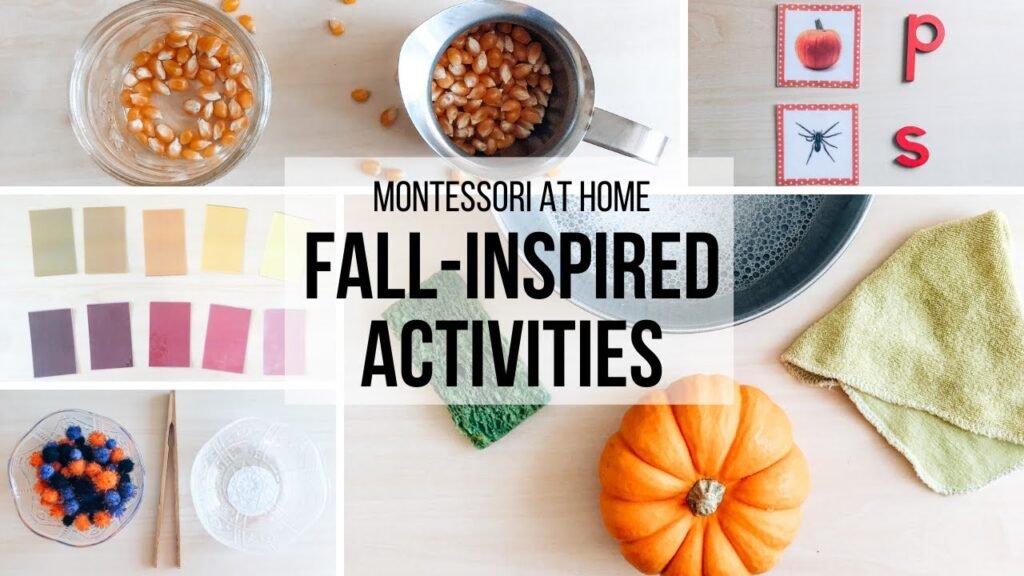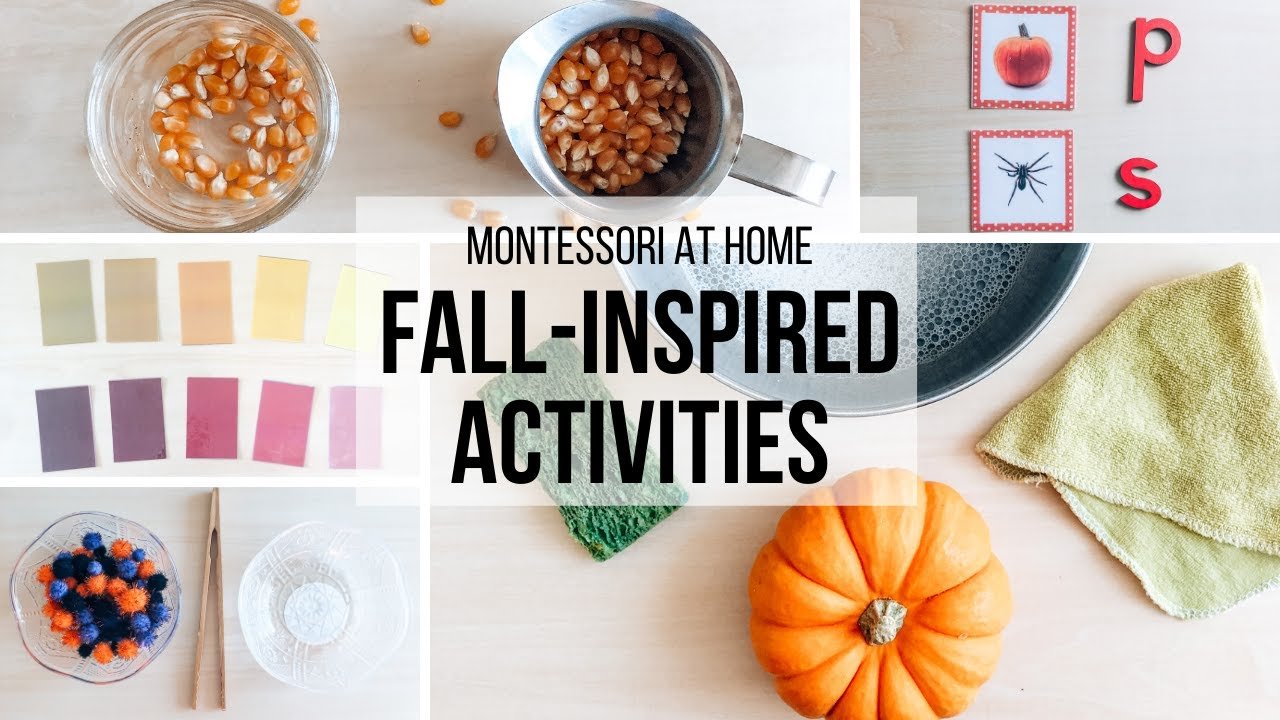Hi there! If you’re a Montessori parent looking for some fun and educational activities to do with your young children this fall season, you’ve come to the right place! In this article, you’ll find 24 simple activities inspired by autumn specifically designed for children in a Montessori environment. From painting matching to pumpkin washing, these activities cover a range of subjects such as sensorial, math, language, arts, and practical life. They are adaptable for children aged 3-6, but can be modified for younger or older children as well.
As a busy parent myself, I understand the importance of engaging and educational activities for children. These fall-inspired ideas have been tested and approved by my own children, and they are sure to bring joy and learning to your home. Whether you’re looking to promote parent-child engagement, enhance fine motor skills, or simply have some fun while learning, these activities are perfect for any Montessori parent looking to infuse the autumn spirit into their child’s learning environment. So why wait? Dive in and explore these 24 simple activities to make this fall season a memorable one for you and your little ones!

Sensorial Activities
Engaging your child in sensorial activities is essential for their overall development and learning process. These activities help them refine their senses and understand the world around them in a hands-on manner.
Painting Matching
Encouraging your child to engage in painting matching activities not only fosters creativity but also helps them develop their visual discrimination skills. By matching pieces of paintings together, they enhance their observation and attention to detail.
Color Grading
Color grading activities are beneficial for children to understand the concept of shades and hues. By arranging colors from darkest to lightest, your child hones their chromatic sense and visual discrimination skills.
Sand Tray Work
Sand tray work is a classic Montessori activity that aids in letter formation practice. It provides a tactile experience for children to trace letters in sand, promoting muscle memory and letter recognition skills.
Math Activities
Math activities are crucial for developing strong numerical skills and problem-solving abilities in young children. Introducing math concepts in a fun and engaging way can set a solid foundation for their future learning.
Counting Beads
Counting beads activity is an interactive way for children to practice counting and number recognition. By counting colorful beads, children improve their numeracy skills and grasp the concept of quantity.
Number Rods
Using number rods in math activities helps children understand number sequences and relationships. Through addition and subtraction exercises with number rods, children enhance their mathematical reasoning and critical thinking abilities.
Language Activities
Language activities play a vital role in developing literacy skills and communication proficiency in children. Engaging children in language activities early on creates a strong foundation for reading and writing in the future.
Letter Practice
Letter practice activities help children learn to write and recognize alphabet letters. By practicing tracing letters and identifying letter sounds, children build essential pre-reading skills.
Rhyming Words
Rhyming words activities enhance phonemic awareness and language development in children. By identifying and matching rhyming words, children improve their auditory discrimination and vocabulary.
Sight Words
Sight words activities focus on teaching children high-frequency words that are essential for reading fluency. By practicing sight words through games and exercises, children strengthen their reading comprehension skills.
Arts and Crafts Activities
Arts and crafts activities allow children to express their creativity and imagination. Engaging in art projects enhances fine motor skills, creativity, and cognitive development in children.
Nature Collage
Creating a nature collage is a sensory-rich activity that encourages children to explore textures, shapes, and colors. By collecting natural materials and arranging them creatively, children enhance their artistic skills and appreciation for nature.
Finger Painting
Finger painting is a fun and sensory activity that promotes self-expression and creativity in children. By using their fingers as brushes, children explore different painting techniques and develop fine motor skills.
Clay Modeling
Clay modeling activities foster creativity and spatial awareness in children. By molding and shaping clay into various forms, children improve their hand-eye coordination and imagination.
Practical Life Activities
Practical life activities are essential for teaching children independence, focus, and life skills. Engaging in these activities empowers children to become capable and self-sufficient individuals.
Pouring Water
Pouring water activity helps children refine their pouring and transferring skills. By practicing pouring water from one container to another, children enhance their hand-eye coordination and concentration.
Transferring Beans with Tongs
Transferring beans with tongs activity strengthens children’s fine motor skills and hand dexterity. By using tongs to transfer beans from one container to another, children improve their grip strength and coordination.
Sweeping
Sweeping activity teaches children the importance of cleanliness and organization. By practicing sweeping floors or designated areas, children learn responsibility and develop gross motor skills.
Science Activities
Science activities ignite children’s curiosity and exploration of the natural world. Engaging in hands-on science experiments and observations fosters critical thinking and scientific inquiry skills.
Sink or Float Experiment
The sink or float experiment introduces children to the concept of buoyancy and density. By testing various objects in water to see if they sink or float, children learn about scientific principles and make predictions.
Planting Seeds
Planting seeds activity teaches children about plant life cycles and growth processes. By planting seeds and observing them germinate and grow, children learn about the importance of nurturing living organisms.
Nature Observation
Nature observation activities encourage children to explore the outdoors and discover the wonders of nature. By observing plants, insects, and animals in their natural habitats, children develop an appreciation for biodiversity and environmental stewardship.
Outdoor Activities
Outdoor activities provide children with opportunities to connect with nature and engage in physical exploration. Spending time outdoors promotes physical health, sensory experiences, and a sense of wonder in children.
Nature Walks
Taking nature walks allows children to explore the outdoors and discover the beauty of the natural world. By observing plants, animals, and natural elements, children develop an appreciation for biodiversity and ecological systems.
Leaf Rubbings
Leaf rubbings activity is a creative way to engage with nature and explore the textures of leaves. By making rubbings of different leaves using crayons or pencils, children enhance their artistic skills and sensory awareness.
Bird Watching
Bird watching activity introduces children to the diversity of bird species and their habitats. By observing birds in their natural environment, children learn about bird behaviors, characteristics, and the importance of wildlife conservation.
Music and Movement Activities
Music and movement activities promote physical coordination, rhythm, and self-expression in children. Engaging in music and movement games enhances children’s auditory, motor, and social skills.
Dance and Freeze
Dance and freeze game is a fun way for children to practice balance, coordination, and following instructions. By dancing to music and freezing when the music stops, children develop their listening skills and body awareness.
Instrument Exploration
Instrument exploration activity introduces children to different musical instruments and sounds. By experimenting with percussion, wind, and string instruments, children enhance their auditory discrimination and musical creativity.
Singing Songs
Singing songs activity encourages children to express themselves through music and vocalization. By learning and singing songs, children improve their language skills, memory retention, and emotional expression.
Social Studies Activities
Social studies activities help children learn about diverse cultures, traditions, and communities. Engaging in social studies activities fosters empathy, cultural awareness, and appreciation for global perspectives.
Community Helper Dramatic Play
Community helper dramatic play activity allows children to role-play different professions and roles in society. By acting out scenarios of community helpers, children learn about social responsibilities and career exploration.
World Map Puzzle
World map puzzle activity introduces children to geography and world cultures. By assembling a world map puzzle, children learn about continents, countries, and global landmarks.
Cultural Food Tasting
Cultural food tasting activity exposes children to diverse cuisines and culinary traditions from around the world. By sampling foods from different cultures, children develop a palate for global flavors and appreciation for multiculturalism.
Fine Motor Skills Activities
Fine motor skills activities focus on strengthening hand muscles, coordination, and finger dexterity in children. Engaging in fine motor skills activities prepares children for writing, drawing, and other precise movements.
Bead Threading
Bead threading activity enhances children’s hand-eye coordination and fine motor skills. By threading beads onto strings or wires, children improve their grip strength and precision in handling small objects.
Pegboard Patterns
Pegboard patterns activity challenges children to recreate patterns using pegboards and pegs. By arranging pegs in various patterns and designs, children develop spatial awareness and problem-solving skills.
Lacing Cards
Lacing cards activity promotes hand-eye coordination and concentration in children. By lacing strings or shoelaces through punched holes in cards, children improve their dexterity and focus on detailed tasks.
Incorporating a variety of activities in your child’s daily routine not only enhances their learning but also fosters their overall development in various areas. Encourage your child to explore, create, and engage in different activities to promote growth and curiosity throughout their educational journey.

